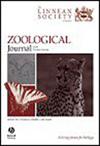Discovering the ancient language roots of zoological nomenclature
IF 2.8
2区 生物学
Q1 ZOOLOGY
引用次数: 0
Abstract
Linnaeus’s Systema Naturae, which introduced the binominal nomenclature, is an unparalleled scientific achievement. Despite its global use over the past four centuries, the language roots of zoological taxa remain unknown. The lack of a standardized method for studying the etymology of scientific terms hinders a thorough understanding on the origin of zoological nomenclature. To address these gaps an interdisciplinary method bridging zoology, linguistics, and chronology of ancient texts has been established. All genera names in echinoderms, one of the most speciose animal phyla, were examined. Evidence highlights the leading contribution of the Greek language in zoological nomenclature. For the first time it is shown that zoological nomenclature is rooted in the 2nd millennium BC (Greek Linear B script) with one third of the elements being sourced in Ilias (the Iliad) and Odyssea (the Odyssey), the emblematic Greek epic poems dated in the 1st millennium BC. The study elucidates for first time the Greek 3400-year-old language roots of zoological nomenclature. Most language elements are sourced in poetic, philosophical, historic, and economic rather than biological texts unravelling the dispersal of language elements across remote human-knowledge fields for at least 3400 years. The established method is transferable serving much-needed interdisciplinary research on the language roots and evolution of modern scientific terminology.发现动物命名法的古代语言根源
林奈的《自然系统》引入了双名命名法,这是一项无与伦比的科学成就。尽管在过去的四个世纪里,它在全球范围内使用,但动物分类群的语言根源仍然未知。缺乏研究科学术语词源的标准化方法,阻碍了对动物命名法起源的深入了解。为了解决这些差距,建立了一种跨学科的方法,将动物学、语言学和古代文本年表联系起来。棘皮动物是物种最多的动物门之一,本文对棘皮动物的所有属名进行了研究。证据突出了希腊语在动物命名方面的主要贡献。这是第一次表明,动物命名法起源于公元前2000年(希腊线形B文字),其中三分之一的元素来源于公元前1000年的标志性希腊史诗《伊利亚特》和《奥德赛》。这项研究首次阐明了希腊3400年前动物命名法的语言根源。大多数语言元素来源于诗歌、哲学、历史和经济,而不是生物文本,揭示了至少3400年来语言元素在遥远的人类知识领域的分散。所建立的方法是可转移的,为现代科学术语的语言根源和演变的跨学科研究提供了急需的服务。
本文章由计算机程序翻译,如有差异,请以英文原文为准。
求助全文
约1分钟内获得全文
求助全文
来源期刊
CiteScore
6.50
自引率
10.70%
发文量
116
审稿时长
6-12 weeks
期刊介绍:
The Zoological Journal of the Linnean Society publishes papers on systematic and evolutionary zoology and comparative, functional and other studies where relevant to these areas. Studies of extinct as well as living animals are included. Reviews are also published; these may be invited by the Editorial Board, but uninvited reviews may also be considered. The Zoological Journal also has a wide circulation amongst zoologists and although narrowly specialized papers are not excluded, potential authors should bear that readership in mind.

 求助内容:
求助内容: 应助结果提醒方式:
应助结果提醒方式:


